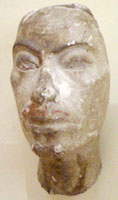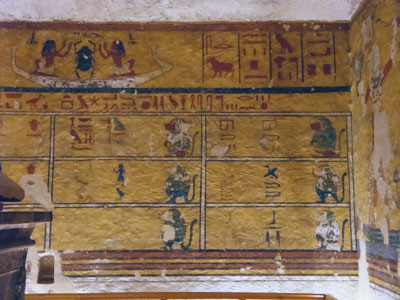
KV 23 is located in the west branch of the West Valley of the Kings, beyond KV 24 and KV 25. It is though that it was the last tomb to be constructed in the West Valley and is generally considered to be the Tomb of Ay (the second last pharaoh of the Eighteenth Dynasty of the New Kingdom of Ancient Egypt). It is sometimes known as WV 23 due to its position in the West Valley which is also known as Wadi el-Gurud (“Valley of the Monkeys” or “Valley of the Baboons”) because of the representation of the baboons of the first hour of the Amduat within KV 23.
No foundation deposits have been discovered to date and so it is difficult to be certain who this tomb was originally intended for. Archaeologists have suggested that its original owner could have been Akhenaten, Smenkhare, or Tutankhamun, with the latter being the most popular option. It is proposed that the tomb had only just been started when the young king Tutankhamun died and so he was instead buried in KV 62 which was in a non-royal area of the Valley of the Kings and had originally been intended for Ay (who at that point was the Vizier of Tutankhamun).
The tomb was discovered by Belzoni in 1816. He marked this discovery by carving the date along with his name and the date beside the entrance. However, it had already been broken into and robbed some time before and there is also copious evidence of deliberate vandalism, which is generally considered to be the work Ay’s successor, Horemheb. Although it was discovered in 1816, it was not fully excavated until 1908 when Howard Carter and his team cleared the tomb.
Layout
Ay’s tomb is of a more simple design than the other royal tombs of the Eighteenth Dynasty, actually bearing more similarity to some of the Twentieth Dynasty tombs. It was built along a fairly straight axis with the burial chamber slightly offset to the north-east. After the doorways there is a descending stair followed by two long corridors divided by a further descending stair. The second corridor leads directly into the antechamber which is followed by the burial chamber and a final smaller annex or canopic chamber.
Decoration
Like KV 62 (the tomb of Tutankhamun, Ay’s predecessor) the only decoration in the tomb is to be found in the burial chamber. The walls are painted with various scenes from the Amduat (Book of the Dead) and representations of the king and various deities.

One famous scene from the tomb of Ay depicts the pharaoh and his wife Tiy hunting for a birds and hippopotamus in the marshes. This is a highly unusual scene for a royal tomb departing as it does from the more common religious scenes.
On the southwest wall of the tomb the nine gods of the Ennead appear with Ra–Horakhty. Ra, Atum, Shu, Tefnut, Geb, Nut, Osiris, Isis, and Horus stand on a barque behind which Nephthys stands. Behind her there is another barque carrying two falcon standards.
On the northwest wall Ay and his Ka receive offerings from Nut and are embraced by Osiris. While on the northeast wall the twelve baboons of the first hour of the Amduat (Book of Amduat) appear. There is also an unusual scene above the doorway to the canopic chamber in which the four sons of Horus are depicted holding flails. To the left of this scene Duamutef and Qebhsenuef wear the crown of Upper Egypt, and on the right Amsety and Hapy wear the crown of Lower Egypt.

The vandalism to this tomb is very thorough. Nearly every image of Ay and his wife Tiy has been hammered out and almost every instance of their names removed. One phrase which remained undamaged describes Tiy as “Great Royal Wife, his beloved, the Lady of the two lands, living, the heiress, great of praises.”
Grave goods
Very little funerary equipment was found in the tomb of Ay. A number of fragments from the Ay’s red quartzite sarcophagus were scattered around the tomb. The sarcophagus is very similar in design to that of Tutankhamun with Isis, Nephthys, Selqet (Serqet), and Neith each carved into one of the corners to protecting the king. It was been repaired and returned to the tomb, but Ay’s mummy has not been found and is presumed to have been destroyed.
- Buy Tutankhamun perfume oil from Kemet Design
- Tomb of Tutankhamun
- Tutankhamun
- Tutankhamun cache (KV 54)
- Was Tutankhamun murdered?
- “Curse” of Tutankhamun’s tomb
- Ankhesenpaaten (Ankhesenamun)
- Amarna Royal Family
- Amarna Religion
- Amarna Letters
Copyright J Hill 2010